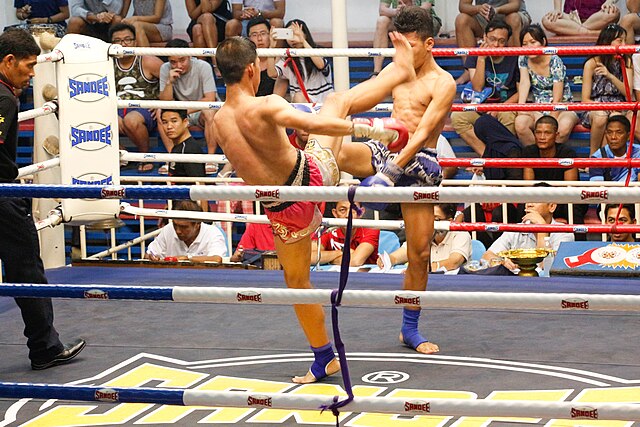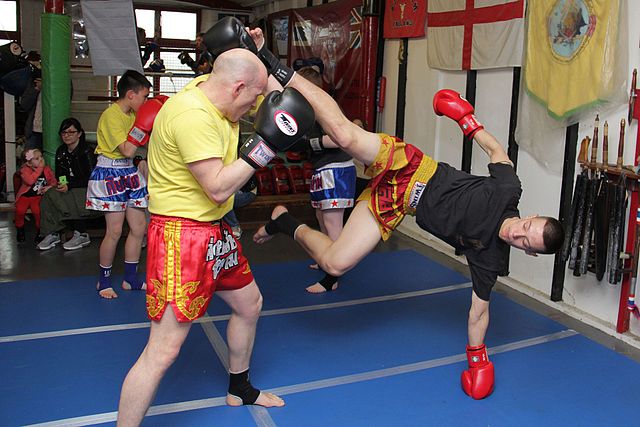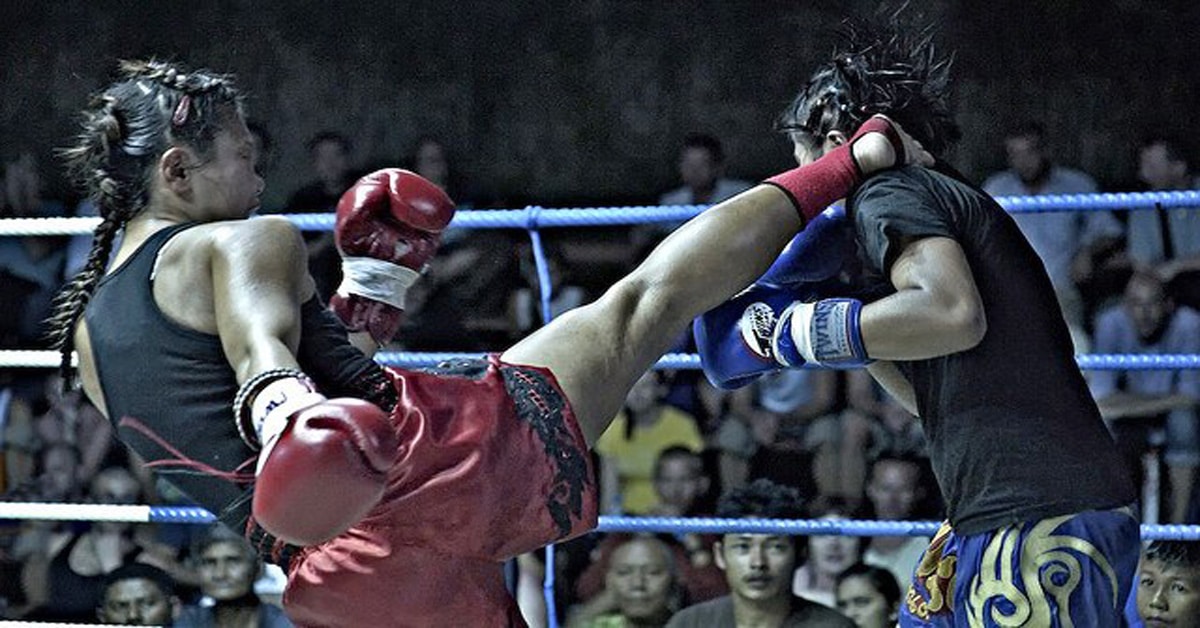Muay Thai Footwork: Explained
Muay Thai footwork is one of the least talked about but most important aspects of Thai boxing. All of the great Thai boxers had incredible footwork that helped them become legends.
Here is a complete guide for how to develop good Muay Thai footwork. Reviewing how to practice Muay Thai footwork, along with details to remember for improving it and mistakes to avoid.

Is There Muay Thai Footwork?
Muay Thai footwork is an important aspect of Thai boxing. Good footwork in Muay Thai improves your abilities in every aspect of the sport.
Everything from your movement, offense, and defense improves when you develop good Muay Thai footwork. It’s not as talked about as it should be for its importance in becoming a good Thai boxing practitioner.
How to Develop Good Muay Thai Footwork?
To develop good Muay Thai footwork, you will need to remember three important details.
- Stance
- Movement
- Rhythm
Muay Thai Stance
Before you can work on your footwork, you must establish a good Muay Thai stance. The Muay Thai stance starts with putting your feet slightly less than shoulder-width apart, your lead foot slightly leading.
Keep your knees slightly bent, light feet, and good posture to begin developing good Muay Thai footwork.
Muay Thai Movement
To develop good footwork in Thai boxing, you must understand basic movement. Remember all the movements of the fighting style.
- Move Forward: Lead footsteps first, and the backfoot follows.
- Move Back: Backfoot steps first, and the lead foot follows.
- Move Side-to-Side: Side-to-side movement works the same as walking. The left foot moves to go left, and the right foot moves first to go right, no matter your stance.
Muay Thai Rhythm
Once you’ve grasped the stance and movement, you can develop your Muay Thai footwork rhythm. The movement in Muay Thai is all about rhythm.
When you watch the Thai boxing bouts, the fighters move to the rhythm of the music. Their feet stay light as they subtly bounce on their feet.
Keeping this rhythm allows your techniques to flow and helps you control the match’s tempo. Once you learn Muay Thai rhythm, you can break the rules to hit your opponent and break their rhythm.
Muay Thai Footwork Drills
Countless Muay Thai footwork drills have been created to help improve the footwork of Thai boxers. Here 7 different Muay Thai footwork drills to help improve your footwork and movement.
1. The Most Basic Muay Thai Footwork Drill
The most basic Muay Thai footwork drill breaks down the movement one step at a time. All you’re doing is staying in your Muay Thai stance and practicing how to move.
Beginners will spend hours doing these drills to learn how to move forward and backward, turn, and pivot. Then, once you’ve done rounds of these basic footwork drills, you will put it all together.
New students of Muay Thai need to take the time to do the basic movement drills in the video above.
2. Finding Your Rhythm
Developing rhythm for your Muay Thai footwork can be acquired through constant drilling. The most common rhythm drill in Thai boxing is just lightly bouncing on your feet for 3-4 beats.
If you’re a beginner and want to break it down even further, you can repeatedly lift your knees back and forth. As you lift your knees high, you can check your balance by pausing with your knee high in the air. It mimics the same motion as defending a roundhouse.
After you get that down, you can move around the ring or mat doing your 3-4 count movements. If you’re not listening to Muay Thai music, you can keep the count in your head.
When you develop your rhythm, you can then implement it into your Muay Thai shadow boxing rounds.
3. Muay Thai Footwork Square Drill
Muay Thai footwork is commonly practiced on a 1-meter square on the mat or ring. Within this square, fighters work on their basic movements within the small square.
There’s a variety of different movement drills that you can practice within this square. Everything from moving forwards, backward, turning, pivoting, and head movement.
Then, once you get down the movements, you can start adding strikes with the movements to make it more realistic.
4. Switching Stance Drills
Switching stance to kick is common in Muay Thai, and you must have good footwork to make your switches. The most basic switching drill is standing in place and cross your feet as you jump back and forth.
Once you get that movement down, you can go up and down the mat doing switch-kick roundhouses. Start by going forward and then work on your switches when walking backward.
After doing your switches going forward and backward, you can start practicing your switches moving sideways.
If you have a partner to practice with, you can do all these drills the same way. The bonus of doing these switching drills with your opponent is you can mimic doing the movements in live rounds.
5. Cone Drills
Every striking martial art uses cone drills to improve footwork, and Muay Thai is no different. Plastic workout cones allow you to do countless types of Muay Thai footwork drills.
You can do everything from moving forwards and backward and step in and out of the cones, depending on how you place them.
Watch the video below to learn some solid cone drills to improve your Muay Thai footwork.
6. Head Movement Drills
While a movement drill might not seem like a Muay Thai footwork drill, your feet play an important role. When you slip to the side, your weight shifts to the side the punch is coming from. At the same time, you’re improving your head movement, you’re improving your footwork.
7. Saenchai Footwork Drills
Saenchai is a master of Muay Thai footwork and does numerous high-level movement drills. When Saenchai drills footwork, he moves at a faster rhythm than most fighters.
He has a more pronounced bounce to his footwork, which he uses as a ploy. The Thai boxing legend drills his Muay Thai footwork and attacks all from his fast-bouncing rhythm all at once.
Biggest Mistakes in Muay Thai Footwork
Muay Thai footwork is easy to learn, but you will make common mistakes. Here are the biggest mistakes to avoid when doing Muay Thai footwork.
- Big Steps: Avoid taking big steps in your Muay Thai footwork. They will put you off-balance and be easy to attack.
- Unbalanced: If your Muay Thai stance is unbalanced in any way, your technique will also be unbalanced.
- Crossing Feet: Crossing your feet is a common mistake that will make you an easy target.
- Heavy-Footed: If you are heavy on your feet, your movements and defense will be noticeably slower.
- Out of Rhythm: Not keeping a good rhythm puts everything about your Muay Thai out of whack.
- Standing Tall: If you stand straight up, you make yourself an easier target to hit.

Important Tips To Remember When Executing Muay Thai Footwork
Footwork in Thai boxing must be drilled and trained to improve. Here are important tips to remember when executing Muay Thai footwork.
- Small Steps: Always take small steps to keep your stance and balance.
- Light Feet: Stay light on your feet to move quickly. This will also enable you to throw faster strikes.
- Balanced Stance: Balance your weight equally between your feet in your Muay Thai stance. This will enable you to have a more fluid technique.
- Rhythm: Rhythm is everything in Muay Thai; you must keep it during sparring and pad work.


